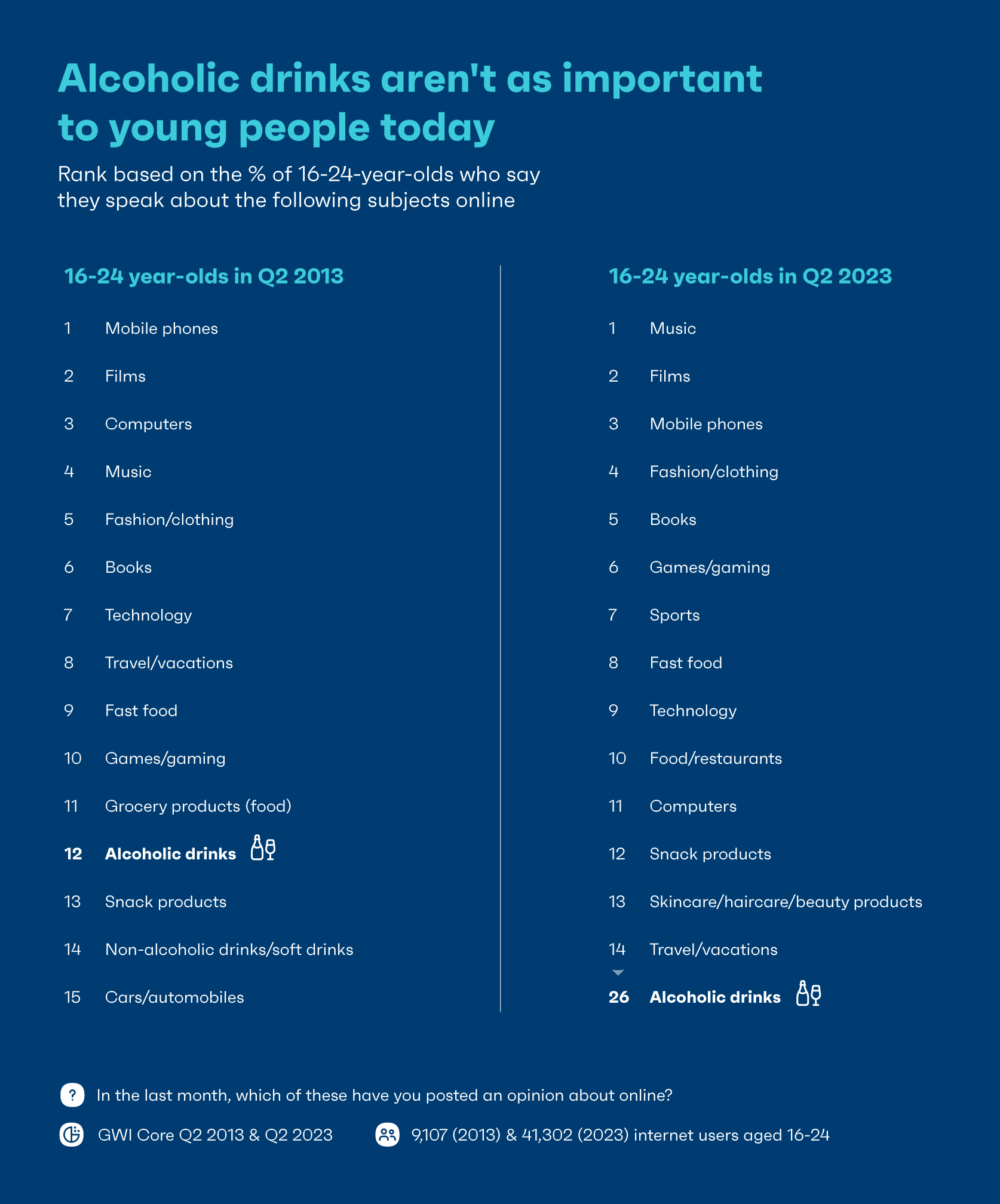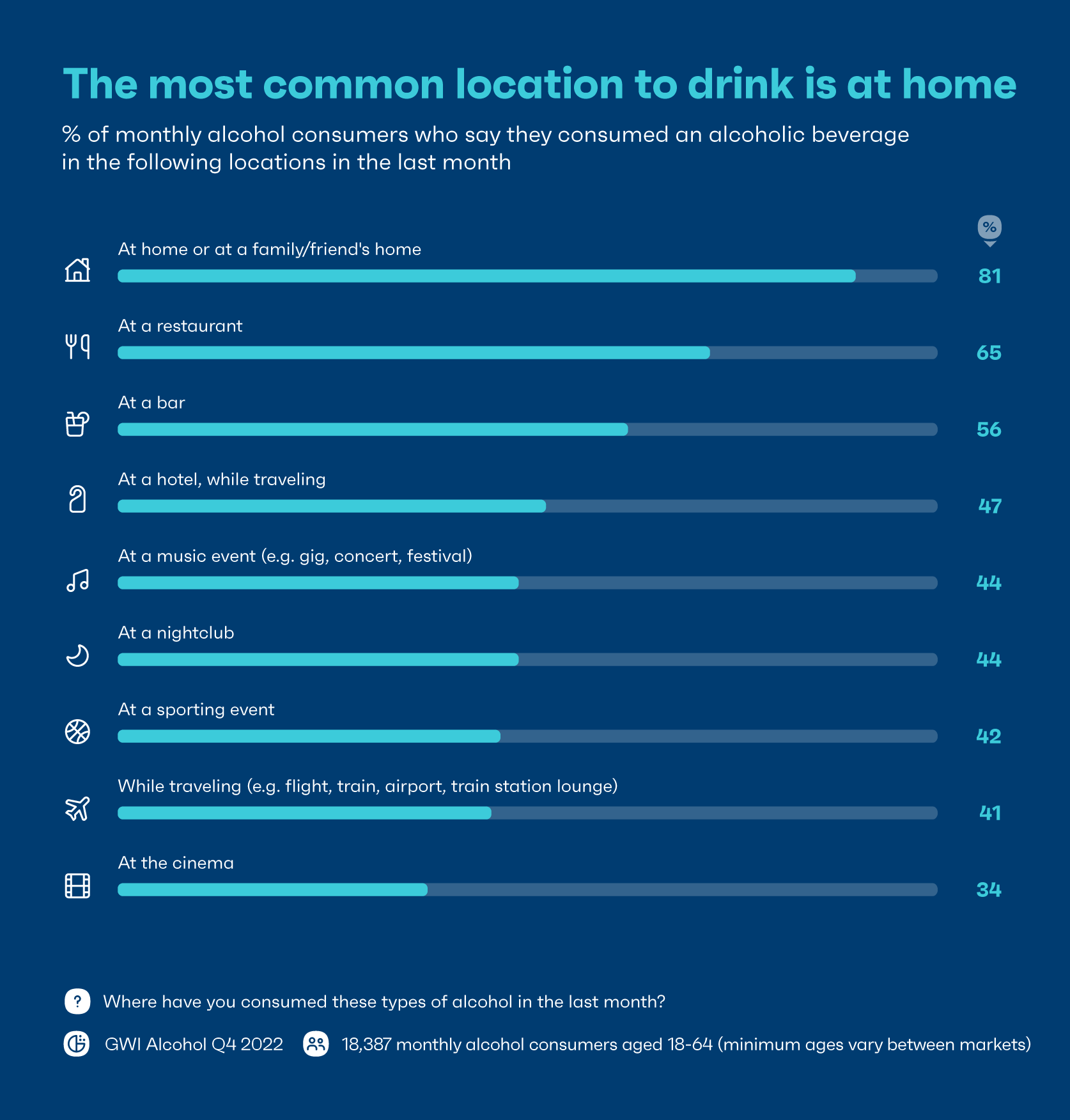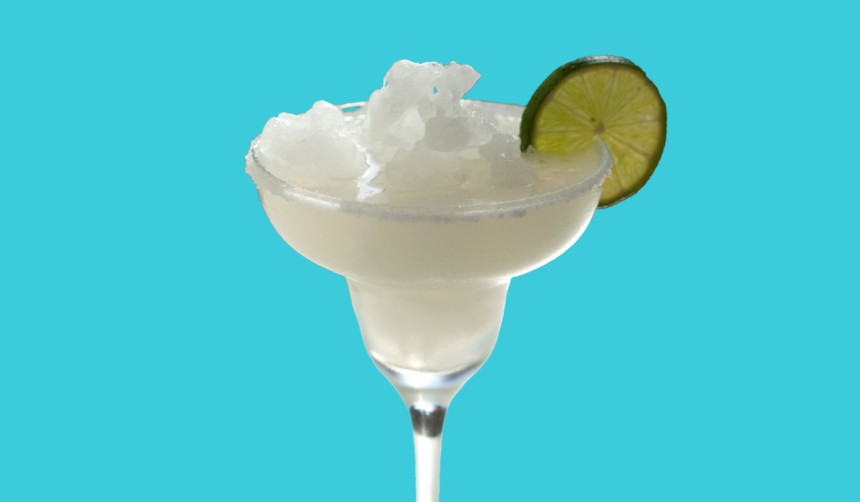Alcohol consumption has taken a hit: the number of global consumers saying they drink alcohol weekly has dropped in the last decade. This doesn’t mean the alcohol industry is drying up just yet, though. In Europe, more people still drink alcohol weekly than eat fast food, but there are new challenges the sector has to adapt to.
A new wave of health-consciousness, lifestyle changes, and shifts in consumer demand means it’s harder than ever to understand the landscape. So, we’ve taken a deep dive into GWI Alcohol to find the biggest trends in the industry, and mixed them together here for you.
Recent trends in alcohol consumption
The 0% drinks wave
The percentage of Americans who drink alcohol is on the decline. Among those in their 30s, interest in beers/breweries (-13%) and cocktails/cocktail bars (-9%) has dropped since 2021. As consumers look to prioritize health and wellness, cutting drinking out of their diets is often a go-to. It’s a valid reason to go tee-total – the most popular reason for consumers to take part in Dry January is to improve their overall health, for example. But we’re seeing a larger cultural shift at play too.
In our US data, we’ve seen a significant increase in the number of Gen Z who say they never consume alcohol. Gen Z are much more likely to say they avoid drinking to save money, avoid hangovers, and avoid getting drunk. Drinking is typically more common among other generations, with a quarter of Gen Z saying they never drink alcohol, compared to 17% of Gen X. They’re 31% more likely than average to say they’re interested in low/no alcohol.
We can see the stark contrast when we compare Gen Z to millennials, based on what they were talking about online back in the dark ages (2013). It’s clear that drinking is less important to the youngest generation, and less character defining.

Gen Z are 12% more likely than average to say they drink no/low alcohol spirits and wines, and they’re more likely to say they’ll never have alcohol while on a dinner date, too. This generation’s relationship with alcohol is very different to that of their parents, which could help shape future generations’ perceptions of alcohol. Non-alcoholic alternatives have recently entered the mainstream; globally, the number saying they drink non-alcoholic beer monthly has risen by 16% since 2018.
People are less willing to compromise their health to stay on trend.
This means that food and drink brands need to rethink their strategies, and the narrative they create around alcoholic products. Guinness and Heineken are two brands heavily marketing the 0.0% iterations of their beers – Gen Z rank them both in the top 5 alcohol brands they consider trendy/cool. Providing a bigger variety of beverage choices, or marketing the benefits of reducing alcohol consumption, will help connect with this growing audience looking to lower their alcohol intake.
More consumers are drinking at home
As much as we’re out of the grasp of the pandemic now, a hangover from life under lockdown has remained – staying in. This mentality shift goes hand in hand with alcohol consumption: in the US, more people drink alcohol at home regularly/often than they do when going out.

It’s no surprise with the current economic climate, consumers feeling the pinch would sooner swap expensive cocktails with drinks purchased at the supermarket. When asking consumers what they’d cut out of their budgets during tough times, alcohol was third on the list, ahead of clothing, beauty, and home entertainment. But to understand how often people drink, it’s worth considering why they’re drinking in the first place.
Bars and nightclubs have traditionally been the go-to places to drink for a big occasion, but more intimate gatherings are now on the rise. Research in our celebrations report found that on the whole, among consumers with a small amount of savings, 35% report celebrating less. But when they are celebrating, there’s more of an emphasis on smaller, casual get-togethers: arts and crafts parties or wellness gatherings.
And when drinks are involved, younger generations are looking to get creative. Gen Z are 22% more likely than average to say that they’re interested in cocktail making, and are more likely to say that they enjoy trying simple drinks that they can replicate at home. Inspo-led social media content can inspire an audience to blend new beverages up in a simple recipe: Pinterest users are 42% more likely to say they’re into mixology than the average drinker, and the hashtag ‘#mixology’ has over 2 billion views on TikTok.
Drinks spilling over to other countries
As globalization continues marching on, we’re consuming more of other countries’ cultures than ever before. You can find examples of this in western teens who love K-pop, bubble tea, and anime. So, what does this mean for alcohol trends?
There’s an appetite for trying new things. Helped by some effective marketing and changing demographics, Americans are getting a taste for Mexican drinks, with more saying tequila is their favorite alcoholic beverage than craft or lite beer. But beverages are traveling further than countries where a border is shared, too.
Spirits from Asia, such as Japanese sake or South Korean soju, have seen their popularity grow in the Western world. And that’s before considering Japanese exports of traditionally western beverages among younger consumers: Gen Z and millennials in the UK and US are 72% more likely than Gen X and baby boomers to say they’ve drunk Roku gin. In return, the Brits have tried their hand at traditionally Japanese alcohol too, as sake has begun cropping up as a food pairing on some of the country’s best menus.
In the UK, the number of millennial restaurant-goers who say that they’re interested in other cultures/countries has increased 9% year-on-year.
Food and beverage trends are intrinsically linked – while food pairing being a significant consideration for alcohol choice when dining out probably isn’t a surprise to many, this factor comes in 3rd for drinking at home – behind only flavor and cost. New alcohol consumption trends can be anticipated by paying a close eye to local food trends. If a cuisine is ramping up in popularity, don’t be surprised to see the country’s beverages close behind.
The craft craze isn’t slowing down
When it comes to drinking, people are looking for something a bit different. This is largely indicative of a wider trend, a sign that consumers are looking for more local options: the number of alcohol drinkers who say that they prefer to buy from local/independent retailers has increased since 2020.
One of the best examples of how the market conditions have facilitated independent drinks brands in recent years is the UK’s booming gin industry. Following the repealing of the 1751 Gin act in 2009, the gin-novation in the market has seen it rise to prominence.
While gin is the least popular alcoholic drink of the 19 beverages we track in 6 global markets, it ranks 5th in the UK.
Craft beer has been a booming industry over the last few years – the number of consumers in the UK who say they drink Brewdog, pioneers of the craft industry, has increased since last year. This is another alcohol trend birthed from the younger consumers. Not only are Gen Z alcohol drinkers 10% more likely to say that they buy from local/independent retailers, but they’re 24% more likely to be drawn to craft, small batch, or locally produced drinks when they’re choosing what to buy to drink at home. They find the look of the packaging even more appealing, which is why brightly colored IPAs and natural wines are resonating so much with younger drinkers.
In addition to bold branding, these beverages are often marketed as more sustainable, eco-friendly, or ethical. These drinks are more than just a tasty treat – they’re a sign of a consumer’s character too, signaling that these consumers are choosing to support brands which resonate with their values.
A low calorie can
While cutting alcohol out altogether is probably the healthiest approach, the top reason those who are looking to reduce their alcohol intake say they do so for health reasons. Globally, out of the 13 characteristics we track, consumers are more likely to describe themselves as health-conscious than creative, price-conscious, or social/outgoing.
To connect with this health-conscious crowd, there has been an increase in the availability of lighter, low calorie beverages such as hard seltzers. While a glass of wine may contain up to 158 calories, a can of White Claw contains just 95. And consumers in North America are taking notice; over a quarter say they’ve drunk a hard seltzer in the last month.
While talking about alcoholic beverages from a health perspective can be a bit of a tightrope walk, low calorie drinks can definitely hit the mark with younger, more active consumers. Since 2020, the number of Gen Z and millennials in the States who have consumed drinks like hard seltzers and hard kombucha has increased by 13%, and among weekly gym goers this increases to 24%.
The big alcohol trends for 2024
Whether consumers are looking to balance their diet, try something from a small brewery, another country, or even go teetotal, the current alcoholic beverage landscape has some key trends to watch out for:
Low-or-no alcohol is on the rise
As more people, particularly Gen Z cut down on their alcohol consumption, brands are racing to meet this demand with 0% iterations of their products. It’s part of an increased focus on health and wellness, but represents a wider cultural shift happening among the youngest consumers.
More are staying in instead of going out
Speaking of cultural shifts, people are opting to stay in. This is a bit of a change in where and why people are drinking, as the reasons they buy alcohol differs from when they’re out and about. Cost is a more important factor, but some are also looking to get creative and mix up new cocktails, too.
People are looking across borders for new drink choices
Just as media and food consumption trends spread around the world, so do alcoholic drinks trends. US drinkers are big on Tequila, while in the UK, Japanese soju is all the rage. More than ever, consumers are looking to switch things up, and try something new.
Smaller breweries are trendy
Independent breweries, small batch gins, and natural wine are all rising trends in alcohol consumption. Whether it be for ethical reasons, or because they just want something a bit different, consumers are looking outside of the big brands.
Health-conscious consumers want a low calorie option
There are more options out there for health-conscious consumers not looking to compromise on their diets. Hard seltzers have been a big hit with gym goers who don’t need the unnecessary calories, and with younger consumers too. Even though it can be a tough line to walk, consumers are looking to make allowances for treats in their healthy lifestyles.









